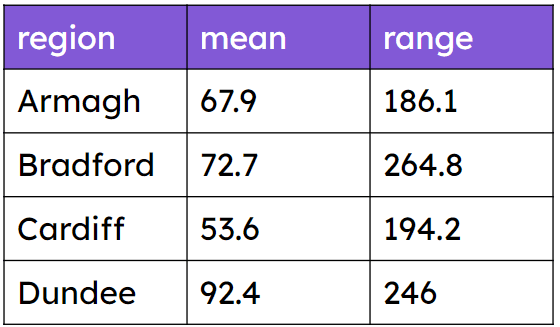Myths about teaching can hold you back
- Year 8
Statistical problems - statistical summaries
I can choose appropriate statistical measures to explore a statistical problem.
- Year 8
Statistical problems - statistical summaries
I can choose appropriate statistical measures to explore a statistical problem.
These resources were made for remote use during the pandemic, not classroom teaching.
Switch to our new teaching resources now - designed by teachers and leading subject experts, and tested in classrooms.
Lesson details
Key learning points
- The type of data may mean that certain statistical measures are not appropriate.
- The nature of the data may mean that certain statistical measures are not appropriate.
- Certain statistical measures may not make sense within the context of the data.
Keywords
Statistical summary - A statistical summary sums up the features of a data set.
Spread - The spread/dispersion of data values describes how far apart the pieces of data are.
Central tendency - a summary measure that attempts to describe a whole set of data with a single value that represents the middle or centre of its distribution
Common misconception
Either the mean, median or mode could be used as an average in any situation.
The choice of average can depend on the type of data. For example, in a list of colours, you can find the mode but not the mean.
To help you plan your year 8 maths lesson on: Statistical problems - statistical summaries, download all teaching resources for free and adapt to suit your pupils' needs...
To help you plan your year 8 maths lesson on: Statistical problems - statistical summaries, download all teaching resources for free and adapt to suit your pupils' needs.
The starter quiz will activate and check your pupils' prior knowledge, with versions available both with and without answers in PDF format.
We use learning cycles to break down learning into key concepts or ideas linked to the learning outcome. Each learning cycle features explanations with checks for understanding and practice tasks with feedback. All of this is found in our slide decks, ready for you to download and edit. The practice tasks are also available as printable worksheets and some lessons have additional materials with extra material you might need for teaching the lesson.
The assessment exit quiz will test your pupils' understanding of the key learning points.
Our video is a tool for planning, showing how other teachers might teach the lesson, offering helpful tips, modelled explanations and inspiration for your own delivery in the classroom. Plus, you can set it as homework or revision for pupils and keep their learning on track by sharing an online pupil version of this lesson.
Explore more key stage 3 maths lessons from the Numerical summaries of data unit, dive into the full secondary maths curriculum, or learn more about lesson planning.

Licence
Prior knowledge starter quiz
6 Questions
Q1.Match each type of average with its description.
the sum of the data divided by the number of data points
the most central (middle) piece of data
the data value with the highest frequency
Q2.The spread of a data set can be measured using the , by subtracting the lowest value from the highest value.
Q3.What is the mode for the data represented in the dot plot? The mode is

Q4.What is the median for the data represented in the dot plot? The median is

Q5.Find the mean for following numbers: 1, 4, 7, 8. The mean is
Q6.Which set of numbers has the greatest range?
Assessment exit quiz
6 Questions
Q1.Which statistical summary is not a type of average?
Q2.Select the type of average that could be used for the following data: dog, cat, dog, dog, fish, cat, cat, hamster, cat
Q3.Each data set has a mean of 50. For which data set is this average the least representative of numbers in the set?
Q4.Select the type of average which would least represent the central tendency of the following data: 1, 2, 5, 6, 7, 10, 10
Q5.The table provide a statistical summary of data about monthly rainfall in four regions. Which region tends to get the most rainfall?

Q6.The table provide a statistical summary of data about monthly rainfall in four regions. In which region is the amount of rainfall most consistent?



